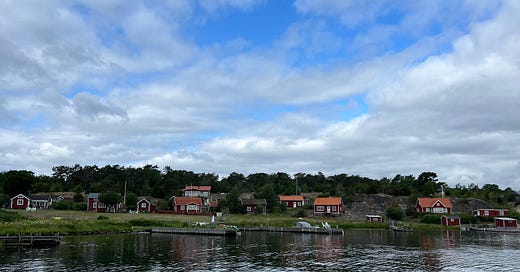Semesterlagen: the right not to work
(Wandering Tärnö, the largest island in Blekinge)
Holidays are eagerly anticipated by most people at some point in the year. Whether it’s a far-off international destination or a staycation, travel and leisure is something many people seek to have. The question, of course, is how much time you can take and what you can afford to do with that time off. Therein lie some crucial differences I’ve discovered since making my move to Sweden.
My perspective is informed by how I grew up, as well as the profession I chose and developed. In brief, I grew up in a household where a strong work ethic was encouraged and rewarded. This meant working in the garden with my mom during the summer months, cleaning the house every week, and looking after my younger siblings when I was in my single-digit and tween years. I don’t recall ever taking vacation, though this was also a factor of growing up on a farm where we had neither the time nor money to do so. In the jobs I took after university and graduate school, hard work and performance-based cultures also rewarded a strong work ethic. Taking time off for vacation started with two or three weeks a year, and eventually I worked up to five weeks in my last role. This was a privileged amount of time relative to many. And to be clear – there is no federal requirement in the United States for time off; it varies by an individual’s contract. Even with time off detailed in my contract, I did not always take it all off. According to research by the Pew Research Center, this is not atypical; about half of workers in the US do not take all of their offered time off. There are several reasons cited for this, but most common responses stated they didn’t need more time, that they worried about falling behind, or they felt bad for leaving co-workers to take on more work.
Depending on how much time one takes, the next question is how much is taken at one time. In my younger years, I would typically take my two to three weeks off, but never consecutively. As I got older and developed further in my career, I earned more time off, but many colleagues raised an eyebrow (or two) when I took three consecutive weeks off. Relative to many of my friends, indeed, three consecutive weeks was not the norm.
Compare this to my first year living in Sweden when I planned to take three weeks off in the summer. As the summer months approached and members of my team started requesting time off, I distinctly remember doing double-takes at the requests. Some requested four, five and even six weeks of holiday! At first, I was perplexed. How could they take so much time off? Will this be a problem for getting work done? And then I realized — these requests are normal. In fact, Sweden’s Annual Leave Act law (Semesterlagen) requires that everyone who works can take five weeks of vacation, and they can take up to four consecutive weeks during the summer months. Most people I know take these consecutive weeks in July and August. If they have younger children, they can take additional time off via parental leave, partially paid for by the state. Hence why they can take more than five weeks off!
The legal requirements for vacation time are noteworthy. But even more so is the fact that people actually take the time off. When people leave for vacation, you can expect them to really unplug from work. No checking email, no “here is how to reach me while I’m out” auto responses. If there is an absolute emergency, sure. But really, it’s time to be with family and enjoy the Swedish summer.
While this amount of time off is surprising to my American-trained brain, research shows the benefits that come with truly unplugging from work. Whether it’s decreasing burnout, increasing energy and engagement, or improving overall health and well-being, it all adds up, and ultimately, improves productivity. Taking vacation is critical.
In this regard, I’m a big fan of the Swedish approach to vacation time. That said, it’s only fair to point out some of the drawbacks as well. For one, salaries in Sweden are much less than what I experienced in the USA. While I do have more time off, I also earn less. So perhaps I can assume that my decreased pay comes at the expense of taking more holiday time, as I’m not contributing directly to the company as much. All that said, expenses are not apples-to-apples between the countries (and I will write more on this in a later post). Things that cost a lot more in the US (e.g. children’s summer camps) are state-subsidized here, so much more affordable. I also (generally) like that I get to be with my children more when they are off from school. Whereas in the USA I could count on summer camps to fill my children’s time when they were out of school, here even the summer camps shut down for several weeks. What?! They actually expect us to spend time together as a family? What a novel concept! 😉
With that, I am doing a proper Swedish summer this year and enjoying 4.5 consecutive weeks off to enjoy a combination of staycations and Swedish explorations. Now three weeks into my time off, I’ve explored more of Skåne, Blekinge and Höllviken/Falsterbo in southern Sweden with R (M was off at sailing camp), and this past week included Stockholm and Copenhagen. Biking and training to discover more of the gems of this beautiful country. Feeling very Swedish right now!
(Hiking with R and L in the Kullaberg Nature Reserve)
(Discovering the Nimis installation just outside of Kullaberg)
(Walking through the wetlands nature reserve: Jonstorp-Vegeåns estuary)
(Moving toward sunset after a storm in Höllviken)
(Delighting in the Kusama installation at the magical Louisiana Museum)









